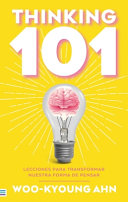

Critical thinking is the cornerstone of effective decision-making and problem-solving. In 'Thinking 101', the author emphasizes that critical thinking enables individuals to analyze situations, evaluate evidence, and draw logical conclusions. This skill is essential not only in academic settings but also in everyday life and the workplace. By cultivating critical thinking, people can avoid cognitive biases and make more informed choices. The book provides various strategies to enhance critical thinking, such as questioning assumptions, considering alternative perspectives, and evaluating the credibility of sources. The author also illustrates how critical thinking can lead to better outcomes in personal and professional contexts, making it a vital skill in today's complex world.
Continue readingCognitive biases are systematic patterns of deviation from norm or rationality in judgment. 'Thinking 101' delves into the various types of cognitive biases that affect our thinking processes, such as confirmation bias, anchoring, and availability heuristic. The author explains how these biases can distort our perceptions and lead to flawed reasoning. By recognizing and understanding these biases, readers can learn to mitigate their effects and improve their decision-making abilities. The book includes practical examples and exercises to help readers identify their own biases and develop strategies to counteract them, ultimately leading to clearer and more objective thinking.
Continue readingEmotional intelligence (EI) is the ability to recognize, understand, and manage our own emotions and the emotions of others. In 'Thinking 101', the author highlights the significance of EI in enhancing thinking and decision-making. High emotional intelligence allows individuals to navigate social complexities, communicate effectively, and resolve conflicts. The book discusses the components of emotional intelligence—self-awareness, self-regulation, motivation, empathy, and social skills—and provides insights into how these elements contribute to better thinking. By fostering emotional intelligence, readers can improve their interpersonal relationships and make more balanced decisions that consider both rational and emotional factors.
Continue readingCreative thinking is the ability to think outside the box and generate innovative ideas. 'Thinking 101' encourages readers to embrace creativity as a vital component of effective thinking. The author outlines techniques to enhance creative thinking, such as brainstorming, mind mapping, and lateral thinking. The book emphasizes that creativity is not just for artists or inventors; it is an essential skill for problem-solving in any field. By cultivating a creative mindset, individuals can approach challenges from different angles, leading to unique solutions and breakthroughs. The author shares inspiring examples of creative thinkers and the impact of their ideas on society, reinforcing the importance of nurturing creativity in our lives.
Continue readingStructured thinking refers to the process of organizing thoughts logically and coherently to facilitate understanding and decision-making. In 'Thinking 101', the author advocates for the use of frameworks and models to structure thinking. This approach helps individuals break down complex problems into manageable components, making it easier to analyze and address them. The book introduces various structured thinking tools, such as flowcharts, decision trees, and SWOT analysis, and demonstrates how they can be applied in real-world scenarios. By adopting structured thinking, readers can improve their clarity of thought, enhance their problem-solving capabilities, and communicate their ideas more effectively.
Continue readingThe environment in which we think plays a crucial role in shaping our thoughts and decisions. 'Thinking 101' explores how factors such as physical space, social interactions, and cultural context influence our cognitive processes. The author discusses the importance of creating an environment conducive to effective thinking, whether it be through minimizing distractions, fostering collaboration, or promoting a culture of open-mindedness. The book provides practical tips for readers to optimize their environments for better thinking outcomes, highlighting that small changes in our surroundings can lead to significant improvements in our cognitive performance.
Continue readingIn a rapidly changing world, the ability to learn continuously and adapt to new information is essential. 'Thinking 101' emphasizes the importance of lifelong learning as a means to enhance thinking skills and stay relevant in various fields. The author encourages readers to cultivate a growth mindset, which embraces challenges and views failures as opportunities for learning. The book outlines strategies for effective learning, such as setting goals, seeking feedback, and reflecting on experiences. By committing to lifelong learning and adaptability, individuals can enhance their thinking capabilities and navigate the complexities of modern life with confidence.
Continue reading